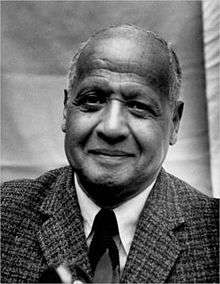Roy DeCarava
| Roy DeCarava | |
|---|---|
 | |
| Born |
Roy Rudolph DeCarava December 9, 1919 Harlem Hospital |
| Died | October 27, 2009 (aged 89) |
| Known for | fine-art photography |
| Notable work |
The Sound I Saw, The Sweet Flypaper of Life |
| Awards |
Guggenheim Fellowship, National Medal of Arts |
Roy DeCarava (December 9, 1919 – October 27, 2009) was an African American artist. DeCarava received early critical acclaim for his photography, initially engaging and imaging the lives of African Americans and jazz musicians in the communities where he lived and worked. Over a career that spanned nearly six decades, DeCarava came to be known as a founder in the field of black and white fine art photography, advocating for an approach to the medium based on the core value of an individual, subjective creative sensibility, which was separate and distinct from the "social documentary" style of his predecessors.[1]
Career in fine art photography
DeCarava produced five books, including The Sound I Saw and The Sweet Flypaper of Life, as well as landmark museum catalogs and retrospective surveys from the Friends of Photography and the Museum of Modern Art in New York.[2][3] The subject of at least 15 solo exhibitions, DeCarava was the first African-American photographer to win a Guggenheim Fellowship and as a result of the fellowship, was able to photograph his community and New York City for one year; expressing early creative impressions through the black and white gelatin silver process.[4] He became well known for his portraits of musicians, and his work appeared on many record album covers, such as Porgy and Bess, by Miles Davis, Bless this House, by Mahalia Jackson, Flamenco Fire by Carlos Montoya, and Big Bill's Blues, by Big Bill Broonzy.[5][6] In 2006, he was awarded the National Medal of Arts from the National Endowment for the Arts, the highest award given to artists by the United States Government.[7]
DeCarava encouraged other photographers and believed in the accessibility of the medium.[8] From 1955 to 1957, at his own expense, he established and supported A Photographer's Gallery in his apartment in a brownstone block at 48 West 85th Street,[1] New York, in which was shown work by the great names of American photography of the period. In 1963, he co-founded and became the first director of the Kamoinge Workshop, a Harlem-Based collective that supported the work of black photographers through exhibitions, public programs, group critiques, and published portfolios.[9]
DeCarava died on October 27, 2009.[10]
Art historical context and commentary
Coming of age in the 1940s, DeCarava appears nothing short of iconoclastic in both his approach to photography, a medium strenuously identified with evidentiary truth, and in his aesthetic ambitions to, as he said, “break through a kind of literalness,” and “express some things I felt.” Maintaining his quest to create a visually autonomous photographic subject of color, DeCarava endured decades of embittering misunderstanding. He has pointed out over and over that despite his “reputation as a documentar[y] photographer, … I really never was,” and reiterated his steadfastly modernist concern to achieve “a creative expression,” rather than a “documentary or sociological statement.”[11]
His largest work is Roy DeCarava: A Retrospective, over 200 black and white photos spanning the late 1940s to the present. Another work of Roy’s is The Sweet Flypaper of Life in 1955. Roy speaks on the piece by saying ”in spite of poverty, you see people with dignity and a certain quality that contrasts with where they live and what they’re doing.”[12] His Guggenheim fellowship helped fund the project while he spent a full year shooting the photographs for the book. He focused on shooting experiences that everybody can relate too.
Selected collection
- Minneapolis Institute of Art, Minneapolis, MN
Works consulted
- The Nation's Capital in Photographs, Corcoran Gallery of Art, 1976. By John Gossage. Edition of 3000 copies.
- Roy DeCarava, Photographs. Edited by James Alinder, Friends of Photography, 1981. ISBN 9780933286276.
- Roy DeCarava, A Retrospective. Museum of Modern Art, New York, NY 1996. ISBN 9780870701269.
- The Sound I Saw: Improvisation on a Jazz Theme. Phaidon, 2000. ISBN 9780714841236.
- Ralph Eugene Meatyard. New York: International Center of Photography, 2004. ISBN 9783865210654. Introduction by Cynthia Young.
References
- 1 2 Kennedy, Randy (October 28, 2009). "Roy DeCarava, Harlem Insider Who Photographed Ordinary Life, Dies at 89". The New York Times. ISSN 0362-4331. Retrieved November 11, 2015.
- ↑ Roy DeCarava and Langston Hughes, The Sweet Flypaper of Life. Washington DC: Howard University Press, 1984 (reprint).
- ↑ "Museum of Modern Art", American Visions, December 1999. Accessed August 23, 2009.
- ↑ Smalls, James (January 1, 2017). "DeCarava, Roy". www.oxfordartonline.com. Retrieved January 1, 2017.
- ↑ Total records : photography and the art of the album cover. Beaupré, Antoine de,, Vincendet, Serge,, Stourdzé, Sam,, Denis, Jacques, 1966-, Mondino, Jean-Baptiste, 1949- (First Aperture ed.). New York, N.Y.: Aperture. ISBN 9781597113847. OCLC 948670847.
- ↑ Borgerson, Janet; Schroeder, Jonathan (2017-11-01). "Recovering and Discovering Album Cover Artists and Photographers". MIT Press blog. MIT Press. Retrieved 2018-04-22.
- ↑ National Endowment for the Arts. 2006 National Medal of Arts. Roy DeCarava. Photographer, New York Archived 2008-10-06 at the Wayback Machine.. Accessed August 23, 2009.
- ↑ Scott, Dread. "An Interview with Roy DeCarava". A Gathering of the Tribes. Brooklyn, New York: A.G.O.T.T. Archived from the original on 2005-02-23.
- ↑ https://lens.blogs.nytimes.com/2016/01/07/kamoinges-half-century-of-african-american-photography// "Kamoinge's Half Century of African American Photography", New York Times, January 7, 2016.
- ↑ Abbie Fentress Swanson, "Photographer Roy DeCarava Dies at 89", WQXR News, October 30, 2009.
- ↑ Stange, Maren (May 29, 2017). "Essay Post 5: Roy DeCarava". marenstange.com. Quotes from the artist, Roy DeCarava. Retrieved 7 June 2017.
- ↑ Robinson, Fern. "MASTERFUL AMERICAN PHOTOGRAPHER ROY DECARAVA." American Visions, vol. 14, no. 6, 1999, p. 20. Academic